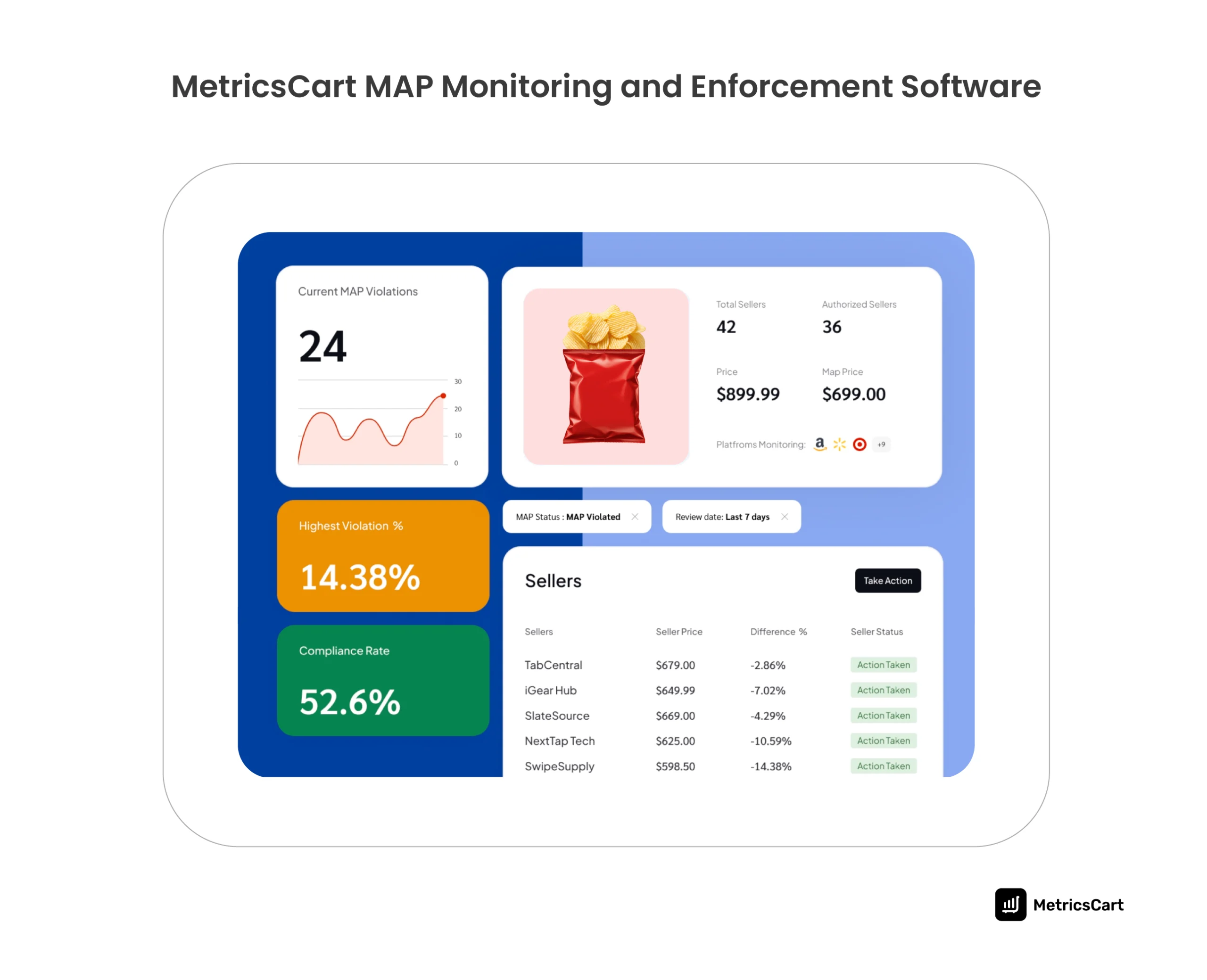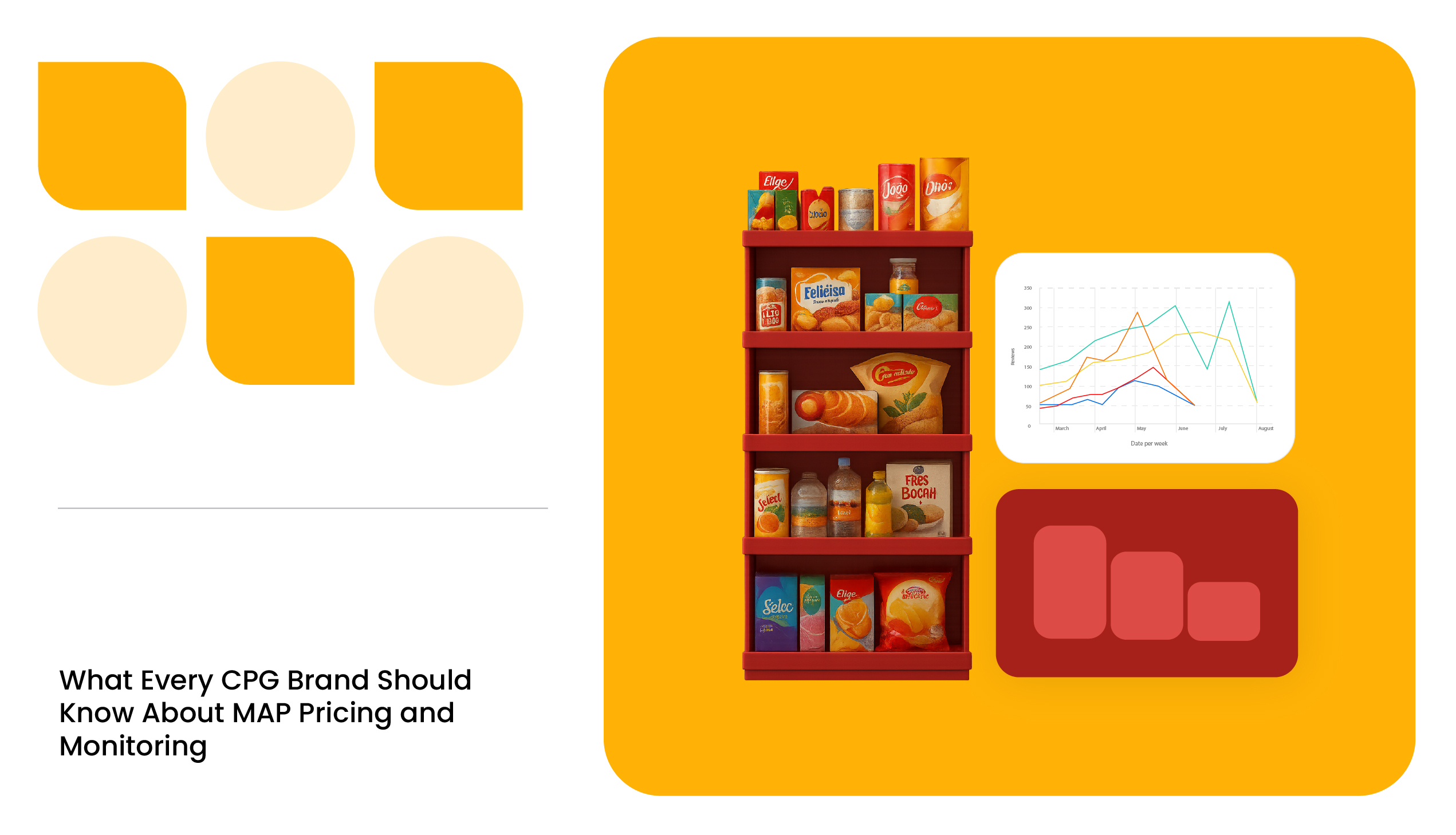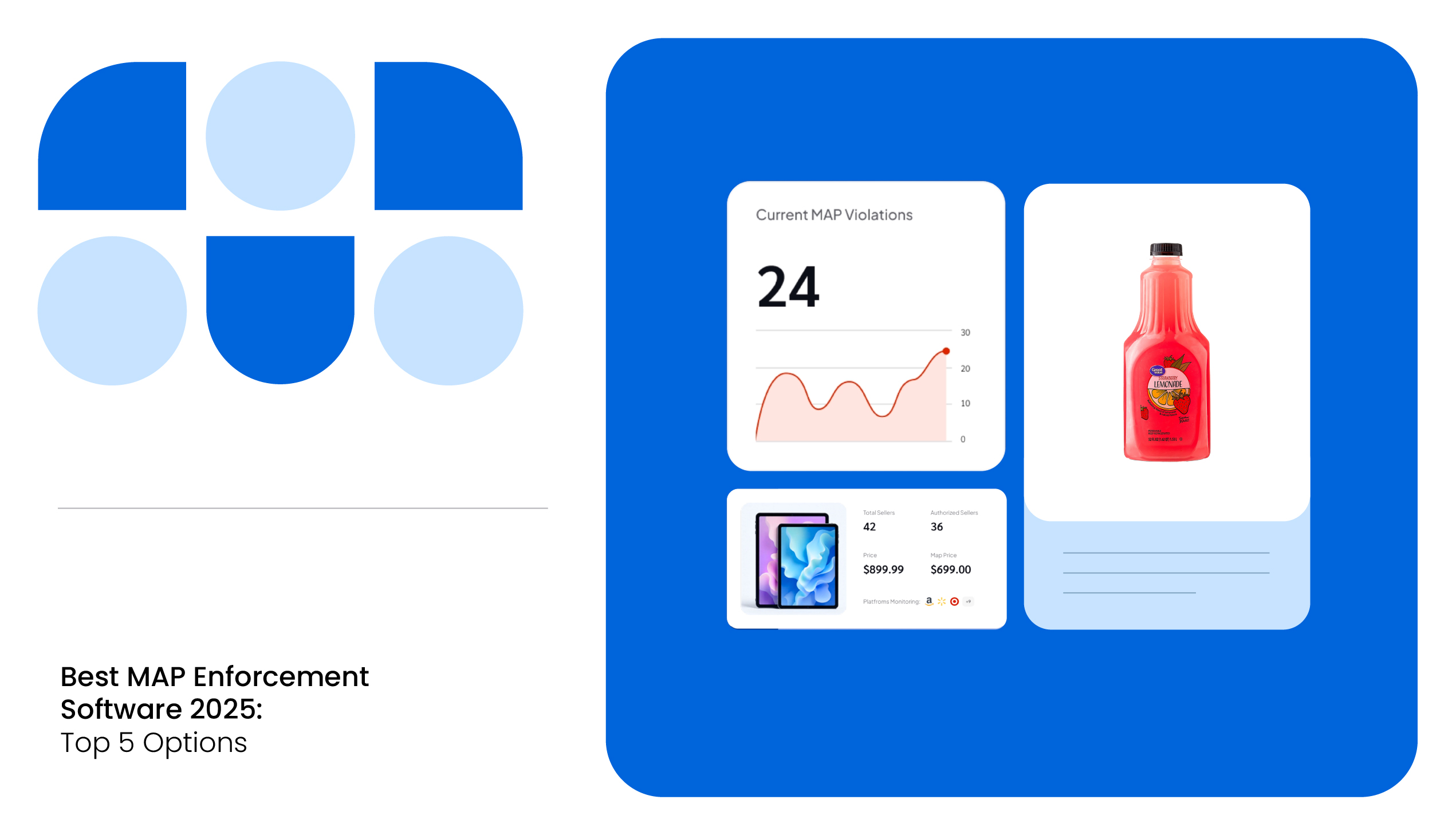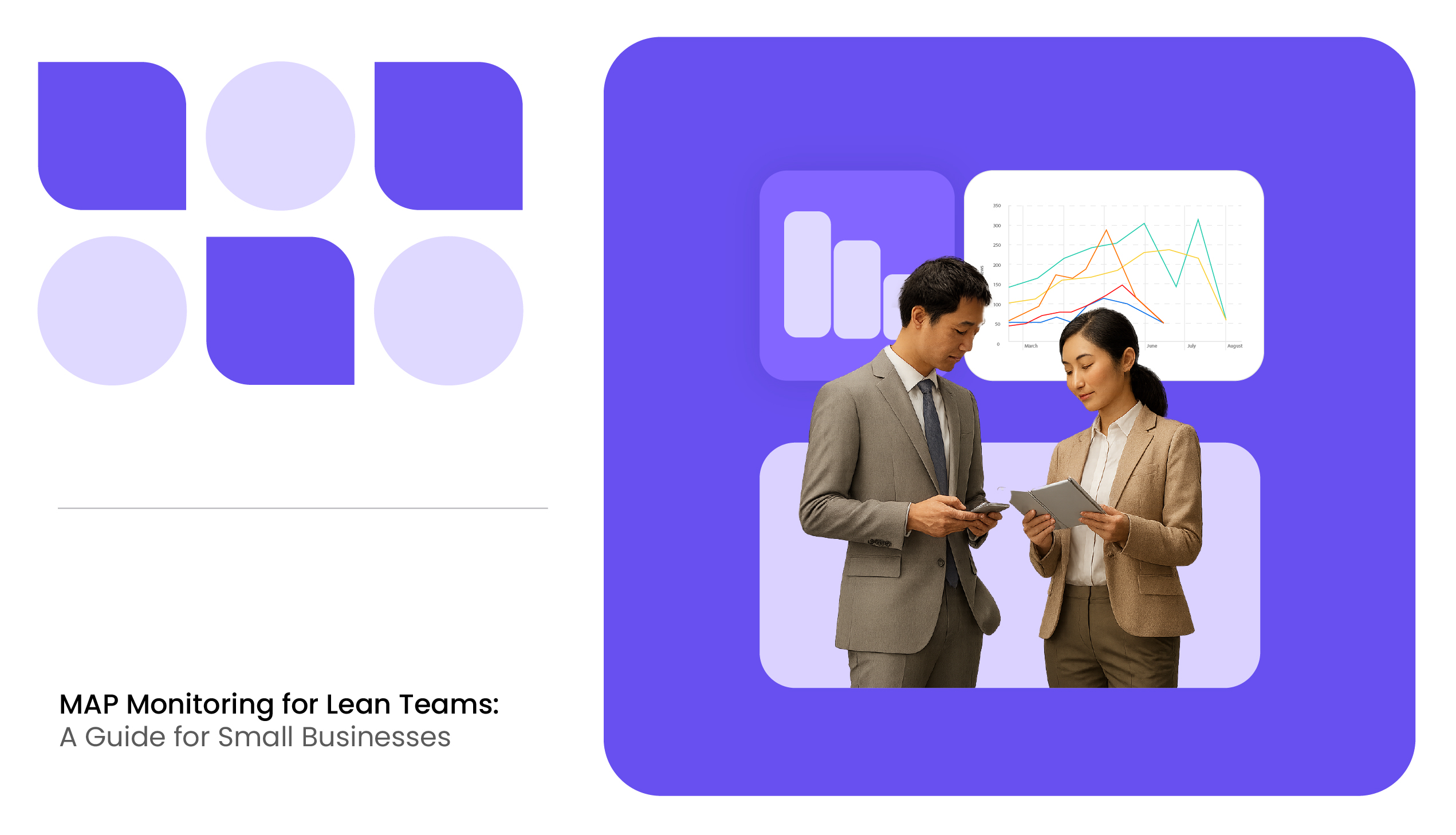If you’re managing a CPG brand, you know how quickly online pricing can spin out of control. One seller drops the price, and within hours, others follow. Before you know it, your product is plastered across marketplaces at a discount you never approved, and your margins, brand value, and retailer relationships are all taking a hit.
That’s where MAP pricing for CPG brands comes in. Minimum Advertised Price (MAP) is your first line of defense. It helps you set the floor for how low your products can be advertised online, keeping price wars, brand erosion, and rogue sellers in check.
But here’s the truth: just having a CPG MAP pricing strategy isn’t enough. You need eyes on every channel, every listing, 24/7. That’s why more CPG brands are turning to MetricsCart.
MetricsCart’s MAP monitoring software is built for brands that sell across multiple online marketplaces. It tracks your product listings around the clock, flags violations instantly, and makes it easy to take action, whether it’s sending a warning or escalating enforcement.
In this post, we’ll break down the benefits of MAP pricing policy for CPG brands, what violations to watch out for, how to track performance, and how to fold MAP into your broader pricing strategy.
Why MAP Pricing for CPGs Matters Today?
Let’s look at why continuous Minimum Advertising Price tracking is essential for CGP brands:
Protecting Brand Equity and Premium Positioning
Pricing is one of the strongest signals of a brand’s value. If CPG products are constantly advertised at cut-rate prices, consumers may perceive them as lower quality or less desirable, eroding the brand’s premium image.
Consistent Minimum Advertising Price tracking and compliance help maintain a stable price across channels, preventing shoppers from getting confused or waiting for discounts that cheapen the brand’s perceived value.
Especially for legacy CPG brands built on quality or for new challenger brands aiming for premium positioning, sticking to MAP reinforces the intended brand positioning and customer trust.
Preventing Price Wars and Margin Erosion
One major purpose of Minimum Advertising Price tracking is to avoid destructive price wars among retailers. If even one seller drastically undercuts the price, others often match it to stay competitive, and a race-to-the-bottom begins. This can rapidly shrink profit margins on high-velocity SKUs and tank revenue.
MAP enforcement sets a level playing field so no retailer feels compelled to keep lowering prices to win sales.
It also preserves healthy profit margins for both the brand and its resellers. As an outcome, brands remain profitable and retailers are more motivated to carry the products (since their margins are protected). In short, MAP pricing for CPG brands is a defensive wall against price erosion and uncontrolled discounting.
Maintaining Retailer Relationships
CPG manufacturers rely on a network of retail partners and distributors. Those partners expect the brand to uphold pricing policies fairly. If some retailers consistently violate MAP and the brand does nothing, compliant partners lose trust. They may push back on trade support, demand better wholesale prices, or even reconsider carrying the brand.
A CPG MAP pricing strategy across all sellers signals professionalism and reliability. It shows you have your retailers’ backs by ensuring no one gets an unfair advantage by flouting the rules. Over time, consistent MAP compliance builds credibility and stronger partnerships, whereas lax enforcement can destabilize those relationships.
Avoiding Channel Conflict and “Gray Market” Sellers
Nowadays, unauthorized third-party sellers (gray market sellers) often list products on marketplaces without approval, ignoring Consumer Packaged Goods MAP policies entirely to offer the lowest prices and secure quick sales.
This not only undercuts authorized retailers but can also lead to product quality concerns or warranty issues. A CPG MAP pricing strategy, backed by monitoring, provides a legal and practical basis to counter unauthorized sellers.
Brands can use MAP violations as a reason to take corrective action, such as issuing warnings or cutting off supply, to protect their channel integrity. In markets like the US, MAP policies are generally legal and can be enforced under antitrust laws as unilateral pricing policies, giving brands a tool to maintain control.
READ MORE | Struggling to Stop Grey Market Sellers? Check out Grey Market Sellers: How They Operate, and Why Brands Should Care
Preserving a Consistent Omnichannel Strategy
Most Consumer Packaged Goods (CPG) brands today sell across multiple channels, including direct-to-consumer sites, online marketplaces, brick-and-mortar stores, and distributors. A MAP pricing policy for CPG brands helps ensure that a product isn’t advertised at different prices in different places, creating a consistent brand experience.
Otherwise, a shopper might see a $49.99 price on the brand’s own site but $44.99 on a third-party marketplace, which not only confuses the buyer but damages the brand’s reputation.
Common MAP Violation Patterns for CPGs and How to Fix Them
Even with a solid MAP pricing policy for CPG brands, violations will occur. Here are some of the most common MAP violation patterns CPG companies face, along with strategies to fix and prevent them:
Rapid Price Erosion from a Single Violation
Pattern: One retailer or online seller drops the advertised price below MAP, and no one notices immediately. In competitive marketplaces like Amazon or Walmart, other sellers quickly see this and drop their own prices to avoid losing the Buy Box or sales volume.
Within days, the product that should be $49.99 everywhere is now $42.99 across multiple sellers, making your product 15–30% cheaper everywhere in a short time. The effects include lower margins on a top-selling item and upset authorized MAP complaint retailers.
Fix: The key is early detection and rapid enforcement. Consumer Packaged Goods (CPG) brands should monitor online prices continuously or at least on a daily/weekly schedule so that any sub-MAP listing triggers an alert.
In addition, quick action like contacting the seller to correct the price or issuing penalties per policy can stop the cascade. Without a CPG MAP Monitoring software, TTR can stretch beyond 10–15 days, which increases revenue losses. With frequent price checks, companies can cut TTR down to 48 hours or less, sharply limiting the impact of any single violator.
READ MORE | Want to Learn Why Weekly MAP Tracking is Vital for CPGs? Check out Weekly MAP Tracking Benefits for CPG: Why Consistency Matters
Unauthorized or Gray-Market Sellers Undercutting Prices
Pattern: Unauthorized third-party sellers often pop up online, especially on marketplaces like Amazon, eBay, or Walmart Marketplace, and list your products below the MAP price. These could be resellers sourcing products by diverting stock, liquidating, or using other gray channels.
They have little incentive to follow your pricing policy since they aren’t official partners, and they win sales by advertising the lowest price. Unauthorized sellers thrive in the gaps between policy and enforcement.
Fix: First, use MAP monitoring tools for CPGs like MetricsCart that can scan marketplaces and identify sellers offering your SKUs below MAP. Often, the tools will flag whether a seller is authorized or not, helping you focus on truly rogue actors. Once identified, determine how unauthorized sellers obtained your product.
Issue cease-and-desist letters or use marketplace programs to take down listings that violate your pricing policy. Many brands include in their policy that they reserve the right to halt supply to any reseller who doesn’t comply. Some cases may require legal action if the seller is especially harmful.
Leverage features like automated email notices to violators. For example, MetricsCart offers tiered enforcement: an initial warning email, followed by stricter actions for repeat offenders (account suspension, legal escalation).

Hidden Discounting Tactics (Coupons, Bundles, and In-Cart Price Cuts)
Pattern: Not all MAP violations are straightforward, like a listed price drop. Retailers use loopholes or opaque discounts to technically adhere to MAP on the surface while still effectively advertising a lower price. Common examples include coupon code abuse, “in cart” pricing, buy-one-get-one or bundling deals, selective rebates, or loyalty discounts.
This way, the advertised shelf price isn’t technically below MAP, but the sale price is. These tactics can be hard to spot because a cursory price scrape might show the item at MAP, hiding the actual violation behind an extra step. They often spike during big promotional periods, like a site-wide coupon on Black Friday that accidentally applies to your product and violates MAP.
Fix: The first step is to explicitly address these scenarios in your MAP pricing policy for CPG brands. Define that any advertised mechanism resulting in a price below the MAP is considered a violation. This means your policy documentation should mention coupons, rebates, “add to cart” pricing, etc., as being under the MAP rules.
In addition, leverage MAP monitoring tools for CPGs that can detect in-cart pricing or scan for coupon codes advertised alongside products. This helps increase your visibility into these hidden violations.
Over time, update your policies and contracts to close common loopholes. Make sure your authorized resellers understand that a MAP violation isn’t just a posted price, but any method of advertising a sub-MAP deal.
Seasonal Spikes in Violations
Pattern: During major retail events and holidays such as Black Friday, Cyber Monday, and Prime Day, the pressure to offer deals skyrockets. It’s during these times that even generally compliant retailers might slip up. You may notice time-specific surges in MAP violations during these high-volume sales periods.
In short, the holiday season or special sale events create a perfect storm for MAP lapses: retailers feel “everyone is doing it,” and consumers expect huge discounts, making MAP policies more likely to be bent or broken.
Fix: Integrating flexibility in your CPG MAP pricing strategy around known events can strengthen compliance overall. For instance, some Consumer Packaged Goods (CPG) brands pre-authorize a temporary MAP holiday – a set discount that all partners can advertise during a specific period. This way, retailers can compete during the critical sales season without feeling the need to break the rules on their own.
If you choose to allow an exception, document it clearly (e.g., “MAP is reduced by 15% for these SKUs from Nov 25-28”) and communicate it to all sellers. Outside of those exceptions, reinforce that any other violation won’t be tolerated. If a violation is spotted, act immediately; stopping it early can save a lot of margin and signal to the seller that you are vigilant.
Before the holiday season, send a friendly reminder to all partners about the MAP policy and the importance of maintaining it even during sales. Many sellers will respect the policy if they know the brand is serious year-round. Sellers who have faced consequences for violations earlier in the year, in particular, will be more cautious about repeating them during the holidays.
READ MORE | Confused about Selecting the Right MAP Price? Check out Choosing the Right MAP Price: Effective Steps & Strategies
Measuring MAP Pricing Performance for CPG Brands
Implementing a MAP pricing for CPG brands and reacting to violations is only part of the battle – savvy CPG teams also measure their MAP compliance performance. Here are some key MAP compliance KPIs that every CPG brand should monitor:
Violation Rate (% of SKUs with Violations): This metric tells you what percentage of your monitored products are experiencing MAP violations at a given time. A high violation rate means many products are being undercut..
Time to Resolution (TTR): This measures how fast you resolve a violation on average, from the moment a price break is detected to the moment the price is corrected back to compliance. TTR is critical because the longer a violation persists, the more damage it can do.
Number of Repeat Offenders: This metric tracks how many sellers (or specific retailer accounts) have violated your MAP multiple times in a given period despite warnings. A high number of repeat offenders could mean your enforcement actions aren’t strong enough to deter violations.
Retailer Compliance Rate: This measures the percentage of your authorized retail partners that are fully compliant with your MAP policy over a given time. A strong compliance rate highlights your most reliable partners, whom you might reward or prioritize.
READ MORE | Want to Learn More About MAP Compliance Metrics? Dive into 5 MAP Compliance Tool Metrics: Tracking What Actually Matters and Why
Making MAP Monitoring a Continuous Strategy
In CPG e-commerce, MAP pricing and monitoring are not set-and-forget tasks but ongoing strategic efforts. But to reap those benefits, brands must back the policy with vigilant monitoring, timely enforcement, and the flexibility to adapt as markets evolve.

The good news is that today, CPG brands have better tools and data than ever to stay on top of this challenge. Investing in a MAP monitoring tool for CPG brands, such as MetricsCart, can greatly simplify tracking and enforcing compliance.
It can track violation trends across channels, send prompt alerts when a violation occurs, and even automate evidence collection (screenshots of the offending price) and email notices to sellers.
With diligent monitoring and enforcement and a trusted partner like MetricsCart MAP Monitoring software, you can confidently navigate the digital shelf, knowing your brand’s value and pricing power are well protected for the long run.
Ready to Monitor and Enforce your MAP Policy with MetricsCart?
FAQs
MAP (Minimum Advertised Price) is the lowest price a reseller is allowed to advertise a product. It doesn’t control the final sale price, but it sets a floor for how products are marketed. For CPG brands, it helps protect margins, prevent price wars, and maintain consistent value across channels.
Yes, in the US, MAP policies are legal if set unilaterally by the brand (not negotiated). Brands can set the lowest advertised price and enforce it by choosing their customers, as long as they don’t fix the actual resale price.
Without MAP, your products can be advertised at deep discounts, damaging brand value and frustrating retail partners. MAP helps avoid price erosion, keeps retailers aligned, and prevents unauthorized sellers from undercutting the market.
Ideally, daily or weekly. In fast-moving online marketplaces, violations can happen overnight. Frequent monitoring helps catch problems early before they spread and do real damage.
Typical violations include undercutting on Amazon, flash sales without approval, “add to cart to see price” tricks, and unauthorized sellers offering deep discounts. Promotions like coupons or bundle deals can also create hidden MAP violations.







